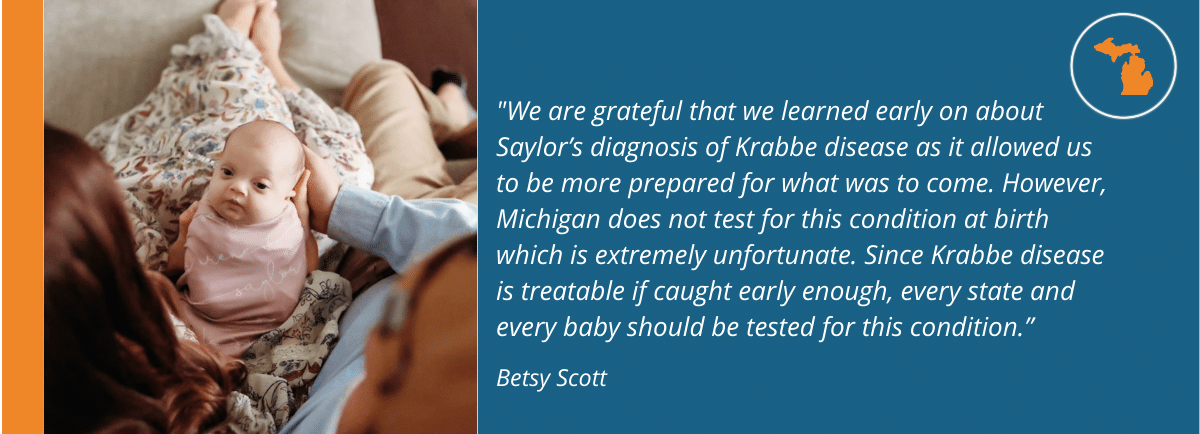DOWNLOAD STATE FACT SHEET AS PDF

In 2020, there were 104,074 live births in Michigan2 There are 58 conditions on the Michigan Newborn Screening Panel3
All babies in the United States are screened for several conditions shortly after birth. Approximately 24-48 hours after a baby is born in the United States, the heel is pricked by a nurse to collect a small sample of blood. Afterwards, the nurse puts a series of blood drops onto a filter paper to create several “dried blood spots.” Next, the newborn screening card is sent to the state laboratory for analysis.
Michigan currently screens for two lysosomal storage disorders, so adding Krabbe disease would add little to no cost.
What is Krabbe Disease?
Krabbe disease (pronounced krab A) is a rare genetic disorder known as globoid cell leukodystrophy. In the United States, Krabbe disease has been reported to affect approximately 1 in 100,000 individuals. Infantile Krabbe disease is the most common and severe form causing infants to lose the ability to eat, extreme irritability, inability to sit up, and grasp objects, blindness, and seizures. Sadly, infants die within the first 2-3 years of life in states that do not test for Krabbe disease. We invite you to learn more about Understanding Krabbe Disease.
Why Screen for Krabbe Disease?
Krabbe disease is a severe neurodegenerative and rapidly progressing condition requiring immediate treatment for the most severe forms. Max was diagnosed with an early onset form of Krabbe disease at 6 months of age. This form, known as infantile Krabbe disease requires treatment within the first 30-45 days of life. If Max was identified at birth with Krabbe disease, Max could have undergone a stem cell transplant. Due to his delayed diagnosis palliative and supportive care were he’s only means of treatment.
Krabbe Disease Hero: Saylor Scott

See all our Krabbe Disease Heroes.
Betsy Scott & Evan Scott tried for almost two years and experienced two miscarriages before finally conceiving their miracle baby, Saylor. In their words, Saylor was the most wanted child ever.
Due to some concerns during their twenty-week anatomy ultrasound, an amniocentesis was performed around week twenty-eight of pregnancy; they learned that Saylor had a deletion of the first chromosome and Krabbe disease. They were told by their Maternal- Fetal Medicine doctor who had never given news like this before and was extremely compassionate. Betsy and Evan were devastated by the news of her rare genetic disorders. They spent the weeks following speaking with doctor after doctor, trying to learn as much as they could about Krabbe, but found that their local specialists didn’t know much about it.
Saylor Irene Scott was born at 37 weeks on 10/21/21 weighing 4 lbs 1 oz. She spent the first eight days of her life in the NICU and came home on a feeding tube and an apnea machine. They flew to Pittsburgh to consult with Dr. Maria Escolar when Saylor was three weeks old. Sadly, Saylor was not a candidate for treatment given that she had two rare genetic abnormalities.
Her parents were in absolute heaven during the short three and a half months they had with their precious daughter and enjoyed every minute – not a second was wasted. They made as many family memories as they could in those months as they never knew how much time they would have with Saylor. She loved snuggling with her mommy and daddy, reading books, bath time, sunrise chats with her nana, and anything pink. She was always happy no matter her circumstances – “the purest most angelic soul you’d ever meet.”
Resources
- The Leukodystrophy Newborn Screening Action Network is dedicated to advancing newborn screening for leukodystrophies and lysosomal storage disorders, supporting newly-diagnosed families, and ensuring collaboration between all stakeholders. Learn more at https://ldnbs.org/.
- CDC offers funding and assistance through the Newborn Screening Quality Assurance Program (NSQAP). More information can be found at https://www.cdc.gov/labstandards/nsqap.html.
- Baby’s First Test provides funding opportunities through grants. Learn more at https://www.babysfirsttest.org/newborn-screening/funding-opportunities.
- American Public Health Laboratories NewSTEPS program provides data, technical assistance, and training. Details at https://www.newsteps.org/.
- KrabbeConnect offers patient support services to help families navigate the burden of Krabbe disease. Learn more at https://krabbeconnect.org/.
- Hunter’s Hope Foundation is a non-profit organization committed to giving hope through education, awareness, research, and family care for all leukodystrophies. Learn more at https://www.huntershope.org/ .
Citations
- Wenger DA. Krabbe Disease. 2000 Jun 19 [Updated 2011 Mar 31]. In: Pagon RA, Adam MP, Ardinger HH, et al., editors. GeneReviews® [Internet]. Seattle (WA): University of Washington, Seattle; 1993-2017.
- “Fertility Rate: Ohio, 2010-2020.” March of Dimes | PeriStats, https://www.marchofdimes.org/peristats/data?reg=99&top=2&stop=1&lev=1&slev=4&obj=1&sreg=26. Accessed 6 Sep. 2022.
- “Minnesota | Baby’s First Test | Newborn Screening | Baby Health.” Babysfirsttest.org, 2015, https://www.babysfirsttest.org/newborn-screening/states/michigan. Accessed 6 Sept. 2022.
All information in this fact sheet is based on data available before September 09, 2022.


